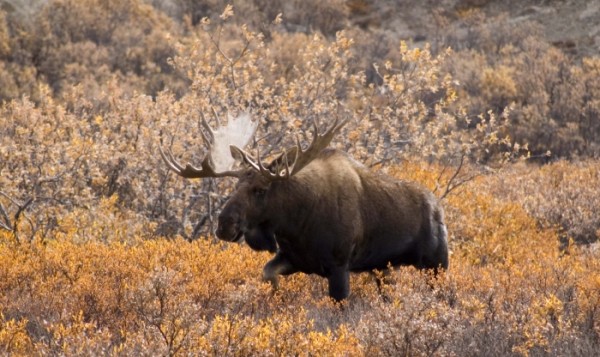Shrubs on warming North Slope attract moose, hares
November 11, 2015
Jeff Richardson
474-6284

Snowshoe hares and moose, which are both relative newcomers to Alaska’s North Slope, may have become established in the area with the help of warming temperatures and thicker vegetation.
A recent study concludes that climate change gradually led to taller shrubs on the North Slope, which provides a habitat boost for animals that take advantage of denser cover.
Ken Tape, an assistant professor with the University of Alaska Fairbanks Water and Environmental Research Center, led the research effort. He said hares seem to be clear beneficiaries of the warming environment — they hadn’t been observed on the North Slope before 1977 but have found a home there in recent decades.
A similar pattern may have helped moose, which hadn’t been reported in the area before 1930.
“If you double or triple the amount of habitat along a river, you might go from having no snowshoe hares and no moose to having them inhabit that corridor,” Tape said.
Results from the study were published last week in the journal Global Change Biology.
Tape said there’s both scientific and anecdotal evidence that such a shift in the ecosystem has occurred in recent years.
North Slope temperatures have gradually increased since the late 19th century, including a particularly rapid climb since the 1970s. The added warmth has caused snowmelt to occur an average of 3.4 days per decade earlier during the past 30 years, based on river flow in the area.
Tape said the longer growing season has resulted in an estimated 78 percent increase in shrub height, based on comparisons made elsewhere on the North Slope. That enabled the typical shrub in the Colville River drainage to grow to about four feet tall — the height needed to support a snowshoe hare population — at some point between 1964 and 1989.
Snowshoe hares apparently did move into the area during that period, followed by lynx, which is one of their primary predators. The absence of hares before then is well documented, thanks to trapping records that date back to the 1920s.
Tape said the arrival of moose on the North Slope within the past century also could be part of that shift, although other factors such as hunting pressure make their migration history more complicated.
Tape said the research team began with the idea that observed changes in vegetation have a measurable effect on species that inhabit the North Slope. He said the histories of hares and moose fit within that model of a warming region.
“If this change is as dramatic as we think it is, we should be seeing that through the lens of wildlife,” Tape said.
Other contributors to the Global Change Biology article include Katie Christie of the UAF Institute of Arctic Biology, Jon O’Donnell of the National Park Service, and Geoff Carroll, with the Alaska Department of Fish and Game in Barrow.
ADDITIONAL CONTACT: Ken Tape, 907-474-2775, kdtape@alaska.edu


